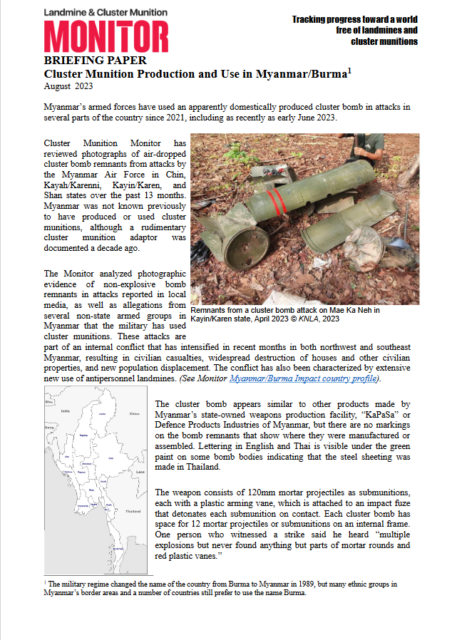Cluster Munition Production and Use in Myanmar/Burma


Myanmar’s armed forces have used an apparently domestically produced cluster bomb in attacks in several parts of the country since 2021, including as recently as early June 2023.
Cluster Munition Monitor has reviewed photographs of air-dropped cluster bomb remnants from attacks by the Myanmar Air Force in Chin, Kayah/Karenni, Kayin/Karen, and Shan states over the past 13 months. Myanmar was not known previously to have produced or used cluster munitions, although a rudimentary cluster munition adaptor was documented a decade ago.
The Monitor analyzed photographic evidence of non-explosive bomb remnants in attacks reported in local media, as well as allegations from several non-state armed groups in Myanmar that the military has used cluster munitions. These attacks are part of an internal conflict that has intensified in recent months in both northwest and southeast Myanmar, resulting in civilian casualties, widespread destruction of houses and other civilian properties, and new population displacement. The conflict has also been characterized by extensive new use of antipersonnel landmines.
The cluster bomb appears similar to other products made by Myanmar’s state-owned weapons production facility, “KaPaSa” or Defence Products Industries of Myanmar, but there are no markings on the bomb remnants that show where they were manufactured or assembled. Lettering in English and Thai is visible under the green paint on some bomb bodies indicating that the steel sheeting was made in Thailand.
The weapon consists of 120mm mortar projectiles as submunitions, each with a plastic arming vane, which is attached to an impact fuze that detonates each submunition on contact. Each cluster bomb has space for 12 mortar projectiles or submunitions on an internal frame. One person who witnessed a strike said he heard “multiple explosions but never found anything but parts of mortar rounds and red plastic vanes.”
This weapon appears to meet the definition of a cluster munition under the 2008 Convention on Cluster Munitions, which prohibits a “conventional munition that is designed to disperse or release explosive submunitions each weighing less than 20 kilograms each.”
On 25 April 2023, cluster bomb remnants were found after an attack by the Myanmar Air Force on a hospital in Saung Pwe village in Pekhon township, southern Shan state, which injured five people including two doctors. However, the casualties could have been caused by other weapons used in the same attack. Also on 25 April 2023, the Myanmar Air Force dropped a cluster bomb near Mae Ka Neh village in Myawaddy township, Kayin/Karen state, that wounded four civilians.
Another attack that resulted in casualties in April 2023, in Mindat township, Chin state, also involved cluster bomb use. Remnants of this same type of cluster bomb were previously found in the same township after a July 2022 air attack that wounded 13 civilians, according to Amnesty International.
Between 17 February and 7 March 2023, the Myanmar Air Force conducted attacks near the villages of Kon Tha, Nam Mae Kon, and Warisuplia, in Demoso township, Kayah/Karenni state, in which witnesses heard multiple explosions indicating the use of cluster munitions. Cluster bomb remnants were found afterwards. A humanitarian worker at the site told the Monitor that, “The aircraft were Yak 130. There were over 20 wounded and seven killed by these strikes. Others were killed by conventional bombs and rockets.”
In December 2022, the Karen Human Rights Group published photographs of remnants of this weapon used in an April 2022 attack in P’Loo village tract in Myawaddy township, Kayin/Karen state, adjacent to the border with Thailand.
In the most recent incident, on 6 June 2023, cluster bomb remnants were documented following an attack by the Myanmar Air Force where a school was damaged, in Kedong village tract in Kawkareik township, Kayin/Karen state.
It is not known when Myanmar began assembling this weapon, but the military used a prototype adapter of more rudimentary design, including repurposed munitions, against an ethnic armed group in Kachin State in late 2012 or early 2013. (See Cluster Munition Monitor 2013).
Cluster Munition Coalition Recommendations
To Myanmar:
- Immediately cease use of cluster munitions and withdraw them from operational service;
- Immediately adopt a national moratorium on the use and production of cluster munitions;
- Survey and clear all areas contaminated by cluster munitions, provide risk education to communities that may be at risk from unexploded remnants, and assist all victims;
- Allow the operations of humanitarian mine action actors; and
- Accede to the Convention on Cluster Munitions.
To all governments:
- Urge Myanmar to stop using cluster munitions and encourage Myanmar to accede to the Convention on Cluster Munitions; and
- Use every opportunity to condemn the use of cluster munitions by Myanmar, including via joint statements and resolutions.

